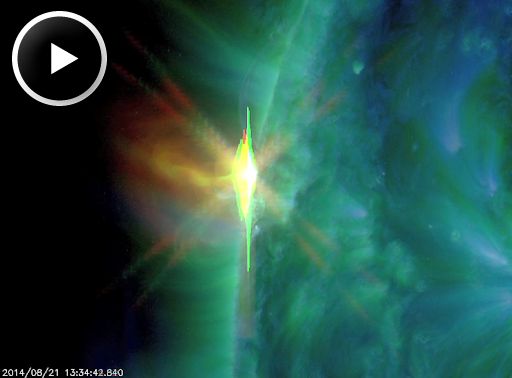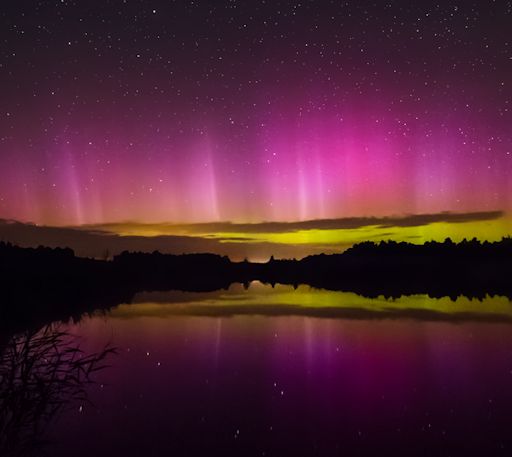When is the best time to see auroras? Where is the best place to go? And how do you photograph them? These questions and more are answered in a new book, Northern Lights - a Guide, by Pal Brekke & Fredrik Broms. | | |
COMET LANDING SITE SELECTION: Europe's Rosetta probe has been at Comet 67P/Churyumov-Gerasimenko for two weeks, taking close-up pictures and making measurements of the comet's strange landscape. According to ESA, researchers now have the data they need to start picking a landing site. This weekend, mission planners will meet to consider 10 candidate locations, with the goal of narrowing the list to 5 by Monday. Stay tuned for results!
SOLAR ACTIVITY PICKS UP: A new sunspot emerging over the sun's NE limb is bringing an uptick in solar activity. AR2149 announced itself on August 21st with an impulsive M3-class solar flare. NASA's Solar Dynamics Observatory recorded the explosion's extreme ultraviolet flash:

UV radiation from the flare partially ionized the upper layers of Earth's atmosphere. This "Sudden Ionospheric Disturbance" altered the normal propagation of VLF (very low frequency) radio transmissions over the northern hemisphere, shown here in a recording from the Polarlightcenter in Lofoten, Norway. The disturbance has since subsided.
Because AR2149 is near the sun's eastern horizon, our view of the region is foreshortened. Evaluating the structure of its magnetic field is therefore tricky. As the sunspot turns toward Earth in the days ahead, we will get a better idea of its flare-producing potential. For now, NOAA forecasters are estimating a 25% chance of M-flares in the next 24 hours. Solar flare alerts: text, voice
Realtime Aurora Photo Gallery
WEAK IMPACT? MAGNIFICENT AURORAS: Visually, the CME that struck Earth's magnetic field on August 19th was dim and unimpressive. The auroras it produced were magnificent. "For the first time in my life, I saw the Northern Lights," says Tadas Janušonis who sends this photo from Vabalninkas, Lithuania:

"It is a very rare phenomenon here in Lithuania," he says, "but the August 19th impact was strong enough to [produce] them."
Actually, the impact was weak. A CME like this one hits with a mechanical pressure of no more than 1 or 2 nanoPascals. That's 1 or 2 billionths of a Pascal - softer than a baby's breath. The reason it was so effective had more to do with its inner magnetic structure. This CME contained a region of south-pointing magnetism that partially canceled Earth's north-pointing magnetic field, opening a crack in the magnetosphere. Solar wind poured and fueled the display.
The most famous photo of the storm, so far, was taken by astronaut Reid Wiseman onboard the International Space Station. "Never in my wildest dreams did I imagine this, " he tweeted. "Unbelievable." Yet many more photos prove that it really did happen! Aurora alerts: text, voice
Realtime Aurora Photo Gallery
WATCH OUT FOR THE CELESTIAL TRIANGLE: For the past week, early risers have enjoyed a spectacular conjunction of Venus and Jupiter in the sunrise sky. The two brightest planets in the solar system have been as close as 0.2o, beaming with ease through city lights and the rosy glow of dawn itself. Now the twosome are becoming a threesome. As this photo from Abhinav Singhai of New Delhi shows, the crescent Moon is joining the show:

"We had a beautiful view of the three bright bodies rising over the India Gate," says Singhai.
Right now the Moon is moving closer to the planets. On the morning of August 23rd, the three will form an almost-equilateral triangle in the pre-dawn sky. NASA previews the meeting in this ScienceCast video.
Realtime Conjunction Photo Gallery
Realtime Comet Photo Gallery
Realtime Meteor Photo Gallery
Realtime NLC Photo Gallery
Every night, a network of NASA all-sky cameras scans the skies above the United States for meteoritic fireballs. Automated software maintained by NASA's Meteoroid Environment Office calculates their orbits, velocity, penetration depth in Earth's atmosphere and many other characteristics. Daily results are presented here on Spaceweather.com.
On Aug. 22, 2014, the network reported 20 fireballs.
(18 sporadics, 2 kappa Cygnids)

In this diagram of the inner solar system, all of the fireball orbits intersect at a single point--Earth. The orbits are color-coded by velocity, from slow (red) to fast (blue). [Larger image] [movies]
Potentially Hazardous Asteroids (
PHAs) are space rocks larger than approximately 100m that can come closer to Earth than 0.05 AU. None of the known PHAs is on a collision course with our planet, although astronomers are finding
new ones all the time.
On August 22, 2014 there were potentially hazardous asteroids.
Notes: LD means "Lunar Distance." 1 LD = 384,401 km, the distance between Earth and the Moon. 1 LD also equals 0.00256 AU. MAG is the visual magnitude of the asteroid on the date of closest approach. | | The official U.S. government space weather bureau |
| | The first place to look for information about sundogs, pillars, rainbows and related phenomena. |
| | Researchers call it a "Hubble for the sun." SDO is the most advanced solar observatory ever. |
| | 3D views of the sun from NASA's Solar and Terrestrial Relations Observatory |
| | Realtime and archival images of the Sun from SOHO. |
| | from the NOAA Space Environment Center |
| | the underlying science of space weather |

